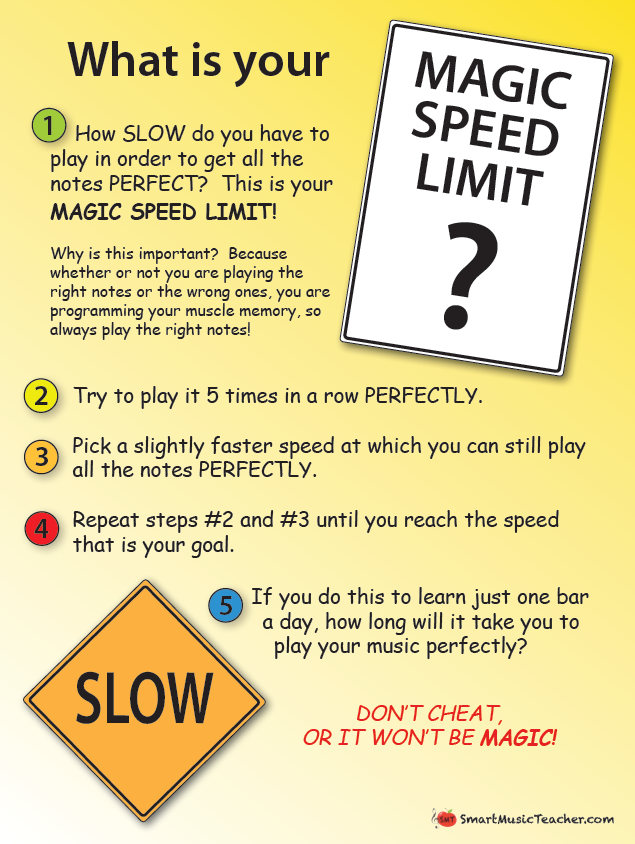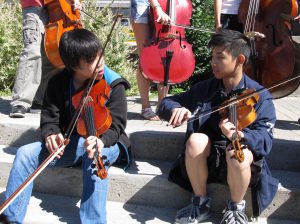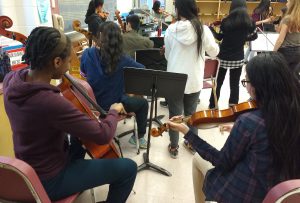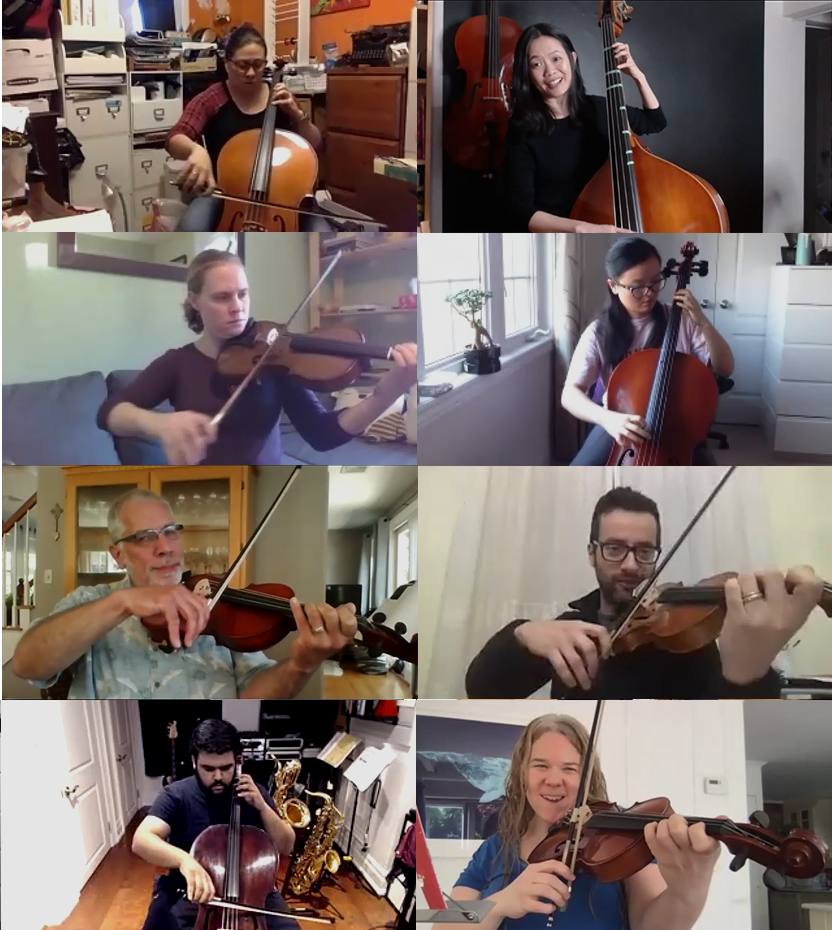Creating an Authentic Aural Traditional Music Experience
Fiddle tunes are short, catchy and pretty easy to memorize. When you put a fiddle tune in front of students, they just can’t wait to play it, and the violas, cellos, and basses can’t wait to get at playing a melody for a change. They are also motivated to make it sound good, so it’s a great opportunity to introduce some new concepts and skills.
Fiddle playing is an aural tradition, and one could decide to be more authentic by teaching tunes completely without music. However, this would be very challenging in a string classroom. So I’ve come up with a process that starts with music but that eventually recreates an authentic experience of playing by ear and sharing tunes by ear.
The Magic Speed Limit
 The first and most important skill I teach in order to lead up to memorization is the idea of practicing properly. The students all have a fresh new piece of music, and the seemingly daunting task of memorizing it, so how are they going to start? This is when I introduce The Magic Speed Limit (poster and full post coming soon). Basically, the Magic Speed Limit involves the steps pictured in the poster on the right. Click on it to see a larger version.
The first and most important skill I teach in order to lead up to memorization is the idea of practicing properly. The students all have a fresh new piece of music, and the seemingly daunting task of memorizing it, so how are they going to start? This is when I introduce The Magic Speed Limit (poster and full post coming soon). Basically, the Magic Speed Limit involves the steps pictured in the poster on the right. Click on it to see a larger version.
It is so important that we teach students how to practice properly. The Magic Speed Limit gets across the idea that whether you play the right notes or the wrong notes, it is all going into your muscle memory, so you might as well slow down and play the right notes. It also points out that you will actually learn your music a lot faster, even if you do this for just one bar of music a day.
That means learning to play a 16 bar tune perfectly could theoretically only take 16 days. However, in a tune there are many bars that are the same, so that could reduce the time to only 10-12 days, etc. In reality, there are also many bars that are pretty easy and that you don’t need the Magic Speed Limit for, so maybe it only takes 5-8 days. In other words, I stress to the students how easy this method actually is, even though it looks like it might be tedious. In fact, it’s the opposite of tedious – it’s a whole lot more fun because you are learning the music so quickly and you feel more successful!
You can read more about the Magic Speed Limit and the importance of teaching students how to practice effectively in my future Magic Practicing Tips series.
Memorization
The most important step to memorization I believe is the previous step – learning the right notes. By that time, they will have found that they have naturally memorized some or maybe most of the tune already. In order to be able to memorize music, the following three things need to happen:
- Learn the written music without any errors.
- Be able to sing the tune perfectly in your head.
- Repetition.
I think step 3 is pretty obvious to most students, and after the Magic Speed Limit, they should be clear on the importance of step 1. However, students will often not realize that a significant key to memorizing a piece of music is to memorize what it sounds like. If they’ve done enough repetition in step 1, this will happen naturally. However, it is always very helpful to point this out and bring it to their attention. It will help them realize that if they don’t have the right notes in their head, then they won’t be able to reproduce the tune accurately.
Luckily, tunes are such a great way to introduce memorization, as they are short, fun, and the melody is pretty easy to catch on to. Most students usually don’t have too much trouble.
Playing by Ear
Playing by ear is a very useful skill to learn, and something that usually doesn’t get very much attention in the string classroom. Playing by ear involves using completely different parts of your brain from reading music, and it is important to exercise these parts. After all, music is essentially the art of sound, not the art of reading written notation.
I tried something new a couple of years ago, and it worked extremely well. When my students had their tune mostly but not completely memorized, I got them to put their music away and try to play it not just from memory, but by ear when they got to the point where they couldn’t play anymore. The idea was that they should all have memorized what the tune sounds like by now (because we’ve played it hundreds of times) and can tell when they’ve played a wrong note. Their job was then to recreate the tune by listening and trying to find the right notes. This simulated what it is like to learn a tune by ear.
Playing by ear teaches students many important skills needed to play music including:
- hearing the right notes in their head before playing them – something that is not necessarily obvious to students when reading music
- holding a tune in their head as they play, which is also an essential skill in order to play music effectively
- recognizing when they have played a wrong note and knowing when to stop and fix it
- being able to keep the tune in their head and continue after playing a wrong note
Even though they are intimidated to be without their music at first, they later admit that it helps them memorize the tune better. And I love watching the wheels in their head turning as they try to play by ear. At this point, I encourage them to trust their ears and continue to practice but without depending on their music.
The Social Experience of Playing and Learning by Ear

There was a missing piece to this experience of learning traditional music that I wanted to create for my students – I wanted to create the social experience of sharing and learning tunes. Last year, by accident that piece finally fell into place. I unexpectedly made it happen one day when I asked the students to pair up with someone playing a different instrument to practice the tune together. What resulted were the perfect conditions for social tune-learning.
Here’s how to set this up:
- First, make sure that a good chunk of the class has memorized or almost memorized the tune.
- Next, have them all put their music away. (I make sure they are in their closed folders and they turn the stands to face me so they don’t cheat when I’m not looking.)
- Divide them into partners with a different instrument and different ability. A different instrument works best because they can’t copy each other’s fingering, but if you don’t have enough numbers for that, that is okay. It’s more important to pair a stronger player with a weaker player.
- Their task is to play the entire tune together.
- If one person gets stuck, the other person has to help them learn it by playing it for them.
- If they are both stuck, then they try to play it by ear together.
What results is exactly what happens in a traditional music setting. It is so much fun for me to watch the classroom become a re-creation of what it is like to share tunes with other people. There is struggle and there is sound. There is laughing and there is learning. There is playing and listening, and there is communication through music.
It was an exciting teaching moment for me when I realized I finally had all the pieces of an authentic tune-playing experience to share with my students. And I was so excited to realize that I finally had all the pieces I needed to set up a fiddle playing programme for other string teachers. It was a real SmartMusicTeacher moment!
But there’s still more! Read on when I finish Part 5 – Teaching Musical Expression and Creativity Through Tunes.
Fiddle Tune Season Series:
Fiddle Tunes for the String Class
Part 1 – Why Teach Fiddle Tunes?
Part 2 – Introducing the Practice of Celtic Fiddle Music
Part 3 – There’s So Much to Learn Through Jigs
Part 5 – Teaching Musical Expression and Creativity Through Tunes




Rebecca Lane
Saving to read tonight!
Smartmusicteacher.com
Great! Thanks, Rebecca!